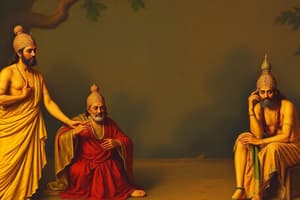Podcast
Questions and Answers
Which empire emerged as a powerful entity under the Mauryan dynasty?
Which empire emerged as a powerful entity under the Mauryan dynasty?
- Magadha (correct)
- Videha
- Kosala
- Gandhara
What was the primary economic activity in the Janapadas?
What was the primary economic activity in the Janapadas?
- Agriculture (correct)
- Commerce
- Trade
- Manufacturing
What did the rise of empires lead to in terms of political power?
What did the rise of empires lead to in terms of political power?
- Consolidation (correct)
- Weakening of empires
- Decentralization
- No change in political structure
Which empire was a rival to Magadha and was ruled by the Ikshvaku dynasty?
Which empire was a rival to Magadha and was ruled by the Ikshvaku dynasty?
Which region was a major center of trade and culture influenced by both Indian and Persian traditions?
Which region was a major center of trade and culture influenced by both Indian and Persian traditions?
What was a key factor that contributed to the rise of Janapadas in ancient India?
What was a key factor that contributed to the rise of Janapadas in ancient India?
Which social group typically held both political and religious authority in Janapadas?
Which social group typically held both political and religious authority in Janapadas?
How did trade and commerce impact the emergence of Janapadas?
How did trade and commerce impact the emergence of Janapadas?
What provided a framework for social and political organization in Janapadas?
What provided a framework for social and political organization in Janapadas?
How were territorial boundaries typically defined in Janapadas?
How were territorial boundaries typically defined in Janapadas?
What played a crucial role in the consolidation of power among tribal leaders in the formation of Janapadas?
What played a crucial role in the consolidation of power among tribal leaders in the formation of Janapadas?
Flashcards are hidden until you start studying
Study Notes
Janapadas
- Emerged in ancient India during the Vedic period (c. 1500-500 BCE) as small kingdoms or tribal states
- Were precursors to larger empires that would arise in later centuries
Factors Leading to the Rise of Janapadas
- Agricultural surplus led to increased food production, supporting a growing population and wealth accumulation
- Development of trade routes connected different regions, facilitating the exchange of goods and ideas
- Political consolidation by tribal leaders led to centralized authority over larger territories
- Spread of Vedic culture and concept of dharma provided a framework for social and political organization
Characteristics of Janapadas
- Ruled by kings or chiefs with both political and religious authority
- Had defined territorial boundaries, often marked by natural features like rivers or mountains
- Society was divided into social classes, with the king and his family at the top, followed by priests, warriors, merchants, and peasants
- Agriculture was the primary economic activity, with trade and commerce also playing a significant role
- Shared a common Vedic culture, including a common language, religion, and social customs
Rise of Empires
- Some janapadas grew in power and influence, conquering neighboring territories and forming larger empires
- Notable examples include:
- Magadha: Located in eastern India, emerged as a powerful empire under the Mauryan dynasty in the 4th century BCE
- Kosala: Located in northern India, ruled by the Ikshvaku dynasty and rival to Magadha
- Gandhara: Located in northwestern India, a major center of trade and culture, influenced by both Indian and Persian traditions
Studying That Suits You
Use AI to generate personalized quizzes and flashcards to suit your learning preferences.




